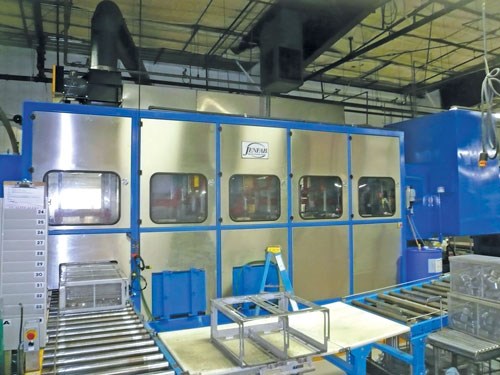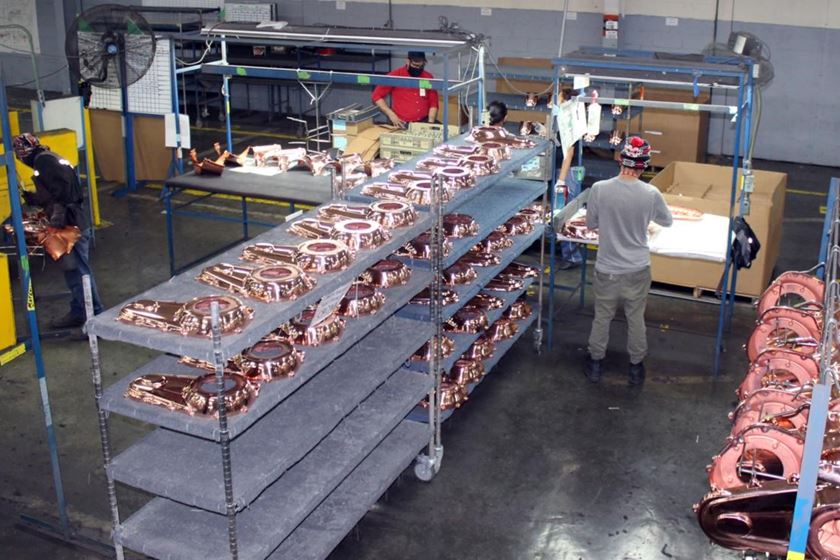Greener and Cleaner: One Company's Environmental Win
Large stamping house reduces its environmental and worker risks.
#sustainability
Eliminating chlorinated and other degreasing solvents for metal parts cleaning continues to command attention for environmental and worker safety reasons.
The phase-out of most ozone depleting solvents in the late 1980s and early 1990s, along with the regulatory limits placed on other chlorinated solvents, prompted manufacturers in many industrial segments to move entirely away from chlorinated solvent cleaning. However, in some segments, such as stamping and other metal forming, chlorinated lubricants remained the standard for decades because of limited alternatives.
Featured Content
Most often, these companies replace solvent vapor degreasing by adopting safer aqueous and organic solvent cleaning options. One of these operations, a large stamping house, wanted to reduce the environmental and worker risks associated with the high volume use of chlorinated solvents in its vapor degreaser.
As the company developed a business case for the full conversion from chlorinated to environmentally friendly custom lubrications needed to manufacture its variety of precision, deep-drawn metal enclosures, cases and stampings in stainless, titanium, brass, copper, cupronickel, and other metals, including some sensitive aluminum alloys, the company also looked at converting from TCE (trichloroethylene) to an aqueous ultrasonic immersion cleaning process.
The stamping house was successfully serving a large number of customers. Business continued to grow, but with a goal of becoming a greener company and reducing the risks associated with handling hazardous materials, an effective replacement for the TCE used in the company’s vapor degreasers had to be found.

A multi-stage, rotary basket, aqueous ultrasonic immersion parts washing system was brought in to replace solvent vapor degreasing.
Safer Alternative
The use of a large cross-rod solvent vapor degreaser and an ultrasonic immersion degreaser dating back to the 80s resulted in, on average, the equivalent of a tank car of chlorinated solvent being on site at any one time. The company’s engineering group was assigned a major project: change stamping lubricants and replace the solvent vapor degreaser with something that would clean these new, yet unspecified lubes from parts. The team was clear in its goal of finding an effective manufacturing method that was also environmentally, community and worker friendly.
The group’s interest was not in any one item that any one vendor brought to the table, but rather in a total solution to meet the overall objectives. Since aqueous cleaning was the obvious choice in reaching the goal of finding an environmentally friendly solution, an aqueous washer company, lubricant (soils) supplier, and cleaning agent manufacturer were selected and brought together to plan this solvent substitution effort.
With careful consideration of the company’s production volume and anticipated rate of growth, as well as the dimensions and shapes of the parts being produced and lubricants used, the group determined that a heated aqueous, ultrasonic and mechanical agitation immersion cleaning method would be an appropriate replacement for the solvent vapor degreasing method.
The customer began development with lubricant, cleaning agent and washer manufacturers to develop new products and processes to manufacture stamping products with robust repeatability. Critical cleaning of manufacturing soil developments were performed concurrently at the company’s R&D lab, aqueous washer manufacturer and Kyzen Corporation’s cleaning applications lab to select cleaning agents, chemistry dilutions, agitation motions and inspection methods.
Greener Methods
Successful developments led to the company moving forward to adopt greener manufacturing methods, initially for one of the company’s product lines. To replace an older ultrasonic immersion solvent system, the company used environmentally friendly lubricants and aqueous cleaning to remove manufacturing soils. It purchased a custom aqueous ultrasonic and mechanical agitation immersion cleaning system using Kyzen’s high alkaline Optisolv OP7168 chemistry in the wash tanks.
The application was successful in cleaning stamping lubricant soils from stainless steel and titanium products meeting the most stringent customer quality requirements. The success met on the manufacturing side was also enhanced when the cleaning waste stream was readily permitted for sewage after neutralization of the spent alkaline chemistry once the process came online. The company changes out the system every two weeks.
Based on the initial success after extensive operations with the first product line, the next phase of moving the rest of the company’s manufacturing method away from chlorinated lubricants and TCE was implemented, but on a much larger scale in volume, product sizes, shapes and metal types.
The additional product lines included an array of metals and soils mixed with an evolving group of stamping fluids. The cleaning agents and methods were adjusted accordingly to optimize the processes for effectiveness and efficiency. A much larger cleaning system was developed using Kyzen’s chemistries to clean the evolved green lubricants used in the initial product line.
This range of variables created a much tougher cleaning challenge, especially on sensitive aluminum stampings, and led to the use of a separate cleaning chemistry, Metalnox M6310, for accommodating the softer, more reactive aluminum stampings, and OptiSolv OP7168 was retained for the rest of the ferrous and non-ferrous metal stampings. A new custom aqueous cleaning system was purchased and installed. The bigger cleaning system is configured similar to the first, with approximately five times the liquid volume per tank, and incorporates a rinse aid (Kyzen Rinse 19) into the final rinse to prevent spotting on parts out of the dryer.
30 Minutes
Almost around the clock, large baskets of stampings are cycled through the process at variable cycle times and with alternate aqueous wash chemistries, depending upon the metal type, soils and production volumes. A tank farm stores wash solutions, which can be changed back and forth between chemistries, as needed, in as little as 30 minutes.
Discharge and disposal of the larger volume of rinsate and water-based detergent from the bigger washer continues to be challenging, and at times, places constraints on production. Developments are in place to replace the current waste stream disposal via filtration, oil separation and evaporation. To better define the optimum change-out frequency for the high volume discharge and best methods of waste stream disposal, Kyzen is profiling each wash bath in the large washer using a range of R&D resources from each of the vendors. This includes test cleaning in production scale equipment, FTIR and other sophisticated surface analyses for contaminant identification and soil characterization.
Development, collaboration and support from various vendors helped to make the company’s full conversion to an environmentally friendly manufacturing process a success. The company continues to receive accolades from its owners, employees and the local community for its environmental awareness and green initiatives.
Originally published in the August 2015 issue.
RELATED CONTENT
-
Stripping of Plated Finishes
The processes, chemicals and equipment, plus control and troubleshooting.
-
Preparation for Electroplating
What you should know about cleaning and electrocleaning.
-
Are TGIC-Free Powder Coatings Right For You?
This alternative to TGIC-based polyester powder coatings offers similar performance and enhanced transfer efficiencies.


















